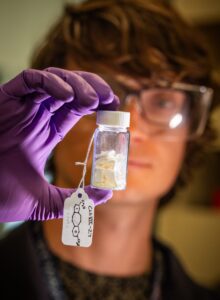
New molecule helps polymers adapt to temperature variations
Canadian Plastics
Materials Research & DevelopmentThe application could be used in everything from plastic phone cases to missiles.

Sandia team member Eric Nagel showing the latest batch of material developed by the team at Sandia National Laboratories. Photo Credit: Craig Fritz
In a development that could be used in everything from plastic phone cases to missiles, a team at Sandia National Laboratories, in Albuquerque, N.M. has developed a molecule that helps change the way some materials react to temperature fluctuations, which makes them more durable.
The problem being addressed relates to one of the biggest factors in materials deterioration: repeated exposure from hot to cold temperatures and back. Most materials expand when heated and contract when cooled, and polymers expand and contract more than competing materials like metals and ceramics.
Erica Redline, a materials scientist who leads the Sandia team, said most items are made up of more than one kind of material. “Take for example, your phone, which has a plastic housing, coupled to a glass screen, and inside that, the metals and ceramics that make up the circuitry,” Redline said. “These materials are all screwed, glued or somehow bonded together and will start expanding and contracting at different rates, putting stresses on one another which can cause them to crack or warp over time.”
Redline said she kept hearing the same complaint from Sandia’s many customers. “They’re always talking about thermal expansion mismatch problems and how their existing systems are hard to work with because of all the filler they need to add to compensate,” she said.
As a solution, the Sandia team modified a molecule so that it can easily be incorporated into a polymer to change its properties. “This really is a unique molecule that when you heat it up, instead of it expanding, it actually contracts by undergoing a change in its shape,” Redline said. “When it’s added to a polymer, it causes that polymer to contract less, hitting expansion and contraction values similar to metals. To have a molecule that behaves like metal is pretty remarkable.”
This molecule could be used in almost endless ways, the Sandia team said, since polymers are used as protective coatings in electronics, communications systems, solar panels, automotive components, printed circuit boards, aerospace applications, defense systems, flooring and more.
“The molecule not only solves current issues but significantly opens up design space for more innovations in the future,” said Jason Dugger, a Sandia chemical engineer who has been looking at potential applications, especially in defense systems.
Another key to this invention is that it can be incorporated into different parts of a polymer at different percentages, in 3D printing. “You could print a structure with certain thermal behaviors in one area, and other thermal behaviors in another to match the materials in different parts of the item,” Dugger said.
Another benefit is helping reduce the weight of materials by eliminating heavy fillers. “It would enable us to do things much lighter to save mass,” Dugger said. “That is especially important when launching a satellite, for example. Every gram we can save is huge.”
Redline said she has also been approached by an epoxy formulator who believes this molecule could be incorporated into adhesives.
The team has only created this molecule in small quantities, but they are working to find a way to scale up production so that other Sandia researchers can test the molecule to fit mission needs. The team is also working to reduce the steps using US$100,000 in funding through Sandia’s technology maturation program, which helps ready products for the marketplace.
